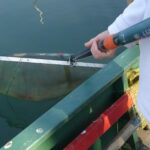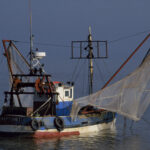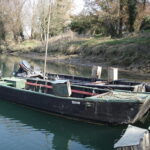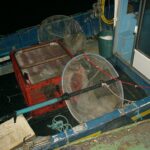Glass-eel
A bonanza that has been exploited for ages on the Atlantic coast
The glass eel, also known as “pibale” in the south-west of France, is a resource that is part of the gastronomic culture of many regions of France and Spain. As far as we can remember, it has always been sought after by the inhabitants of these regions, especially for the end-of-year celebrations when it was and still is a sought-after delicacy. Its fishing was banned in France in 2010 for amateurs, but it continues to support the economy of small estuarine and continental fisheries in many catchment areas flowing into the Bay of Biscay: Adour and coastal streams, Gironde-Garonne-Dordogne, coastal rivers of Charente and Vendée, Loire and coastal rivers of southern Brittany.
Although French production has decreased significantly: from more than 1,500 tonnes in the 1970s to less than 50 tonnes today, French glass-eel production is still the main supply for European countries that farm or restock eels. Without this production, whose quality is recognised, the eel industry in Europe would disappear.
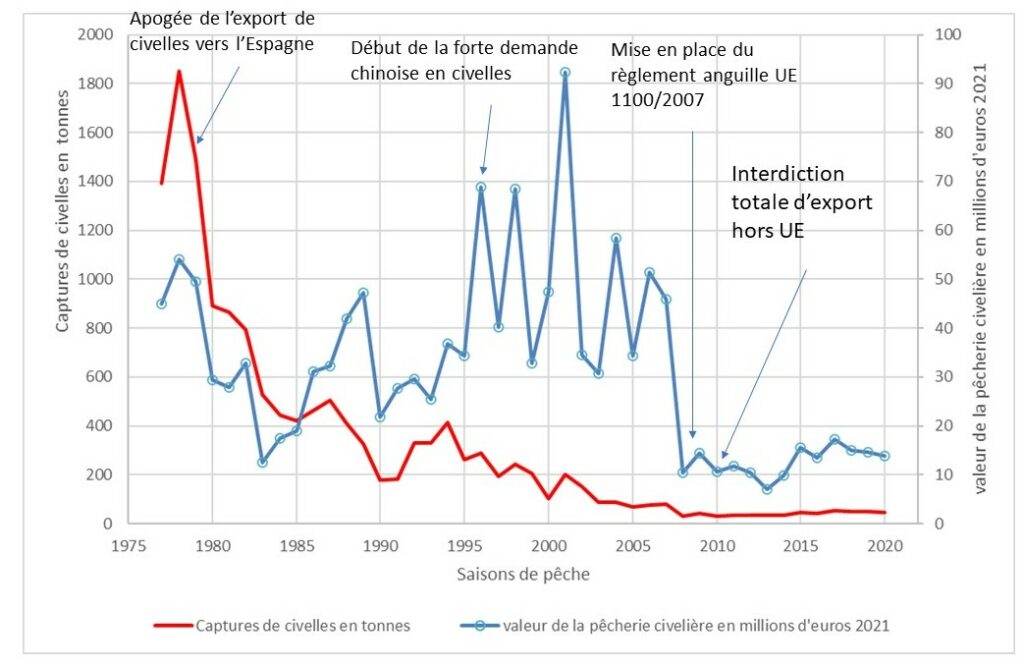
The figure above shows the very sharp drop in catches linked to the reduction in glass eel stocks on the French Atlantic coast, but also to the implementation of very strong constraints on the fishery within the framework of the French Eel Management Plan (PGA): reduction in the number of licences, definition of consumption and restocking quotas (France is the only country in the EU to do so) Since 2008, national catches have averaged 41 tonnes, part of which is destined for restocking in Europe.
Prices per kg have fallen sharply since the ban on eel exports outside the EU
Exports to Asia, which enabled the French glass eel fishery to maintain its high economic value (see previous graph), are no longer possible following France’s decision to prohibit such exports, even though the consumption quota had been defined for this purpose. This ban, which is not linked to a CITES regulation (the Annex II classification does not prohibit export outside the range), is completely incomprehensible from a biological point of view (export outside the EU is only requested from the consumption quota, the purpose of which is to supply direct consumption and farming) and has resulted in an explosion of illegal traffic to China at prices at least 5 times higher than the price practised by the legal trade in Europe. The American glass eel (Anguilla rostrata), which is not listed under CITES, is commonly and legally sold on the Asian market at around 3500 euros per kg, which makes it possible to support this fishery economically while at the same time strongly restricting the number of licences and the volume of catches.
The restocking market, which was supposed to compensate economically this ban for the French glass eel industry, has not been very dynamic since the implementation of UE regulation 1100/2007 and the prices have always been much lower than those for consumption, as shown in the graph below (from France Agrimer data).

A variety of capture methods adapted to the behaviour of the individuals.
In the lower part of the estuaries, the glass eels are carried by the rising tide. Their presence at the surface will depend on the light conditions in the water column. The clearer the water, the deeper the night or daytime light will penetrate, preventing the glass eels from reaching the surface. Thus, the push or hand sieves operating at the surface have little chance of capturing the alevins unless the estuary has turbid water like the Loire or the Gironde for example. In these two estuaries, the clarity of the water column plays a secondary role and the glass eels are often available at the surface, which is not the case in so-called clear estuaries such as the Adour, where the best light conditions for glass eel fishing are those that characterise the black moon with a cloud cover.
Thus, depending on its position on the estuary or on the course of the river, and depending on the maritime or fluvial regulations, different gears.
Hand-held sieves that can explore the smallest nooks and crannies of the banks where groups of glass eels may concentrate, depending on certain hydro-climatic conditions. Anchored sieves, which are used in the Adour and have the same characteristics as hand-sieves, but are positioned near the bottom of the river when the water is clear and the tide pushes the glass eels closer to the bottom. The pushed sieve may or may not have a handle depending on the estuary. On the Adour, for example, given the engine power of the boats, it is still difficult to push the sieve to depth. The sieves are then positioned to filter a volume close to the surface and are not very efficient when the water is clear.
The “pibalours” used in movement or in fixed position have larger surfaces of filtration, but generally operate in wider stretches of river.
Cliquer sur la galerie pour agrandir les photos.
